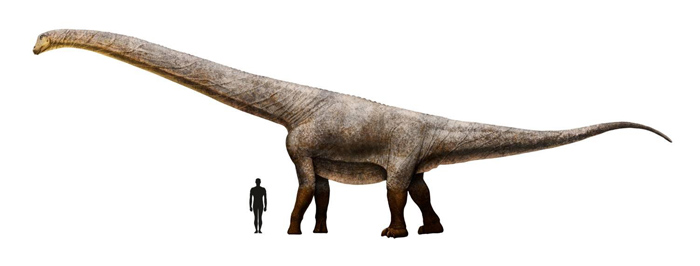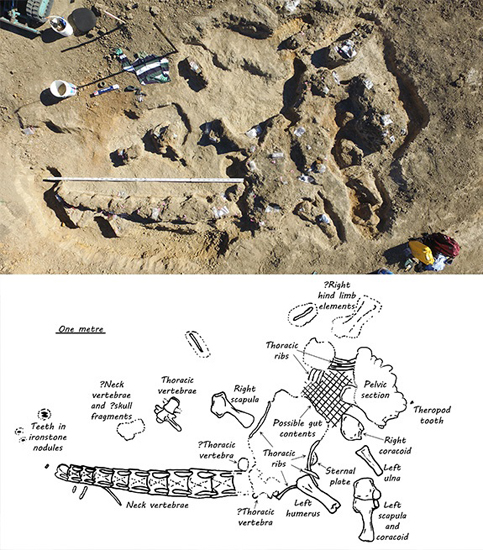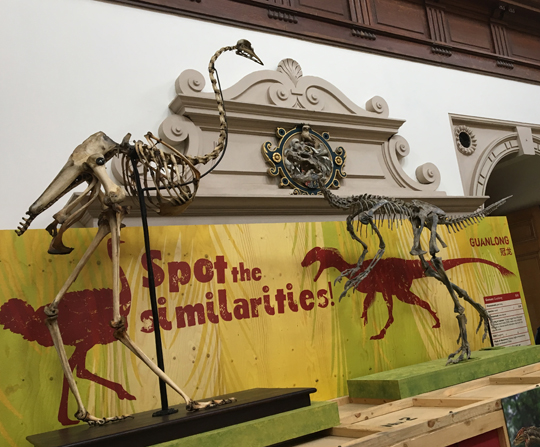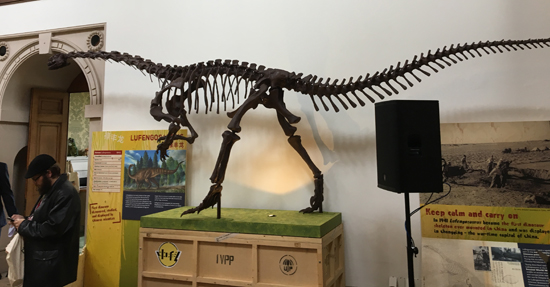New Titanosaur “Judy” from the Outback!
Research Team Excavate Aussie Titanosaur
The fossilised remains of what might turn out to be one of the most complete dinosaur specimens ever found in Australia are currently being excavated near the town of Winton (Queensland, Australia). Although much of the field work has yet to be completed, palaeontologists are confident that around twenty-five percent of the animal’s entire skeleton may be present. If this is the case, then these fossils, representing a single, individual titanosaur, may help scientists to better understand the megafauna of Gondwana during the early Late Cretaceous.
A Scale Drawing Showing “Cooper” Australia’s Largest Titanosaur Fossil Discovery to Date
Picture credit: Dr Scott Hocknell
Winton – The Unofficial Dinosaur Capital of Australia
The discovery was made back in 2015, when a local rancher, Bob Elliott noticed fragments of dinosaur bone on the surface of one of his livestock paddocks. Over the last few field seasons, volunteers, guided by the dig team’s leader Dr Stephen Poropat of Swinburne University (Melbourne), have slowly and steadily been uncovering the treasure trove of dinosaur fossil material. Winton, named after, Winton, a suburb of Bournemouth (Dorset, southern England), is regarded as the unofficial dinosaur capital of Australia as numerous dinosaur fossils have been found.
To date, the team has found four peg-like teeth, at least ten cervical vertebrae, dorsal vertebrae, pelvic material and elements from the shoulder and limbs.
Commenting upon the importance of this dig site in the context of Australian dinosaurs, Dr Poropat stated:
“This just might be the most complete sauropod ever found in Australia. We have probably more than twenty-five percent of the skeleton, which is phenomenal.”
Palaeontologists and Volunteers Working at the Dig Site
Picture credit: Swinburne University of Technology
An Australian Titanosaur Nicknamed “Judy”
The fossil material has been nick-named “Judy”, in honour of Judy Elliott, one of the co-founders of the Australian Age of Dinosaurs Museum in Winton. Although a number of titanosaurs (a type of sauropod), have already been described from fossils found in this region, Dr Poropat believes that this particular specimen will give scientists a better understanding of Australia’s Late Cretaceous long-necked dinosaurs.
The postdoctoral fellow added:
“We will be able to understand many aspects of this sauropod’s anatomy, simply because we have so much of its skeleton. By studying its teeth and neck in particular, we might be able to shed light on how it fed.”
Potential Cololites
The area where the chest and hips are located at the quarry has yet to be fully excavated. The remains of this dinosaur’s last meal might be preserved inside the body cavity (cololites). This would provide direct evidence as to the types of plant material this giant herbivore consumed. If the researchers are able to locate cololites, this would be the first time gut contents in an Australian titanosaur would have been discovered.
An Aerial View of the Dinosaur Dig Site with Accompanying Schematic Drawing
Picture credit: Swinburne University of Technology
Studying an Australian Titanosaur
Dr Poropat explained that these fossils may lead to more questions:
“We still have a lot to learn about many aspects of sauropod behaviour, physiology and in the case of Australia’s sauropods in particular their skeletal anatomy.”
This herbivorous dinosaur was not fully grown when it perished (as indicated by the unfused shoulder girdles), but at around twelve metres in length it was a sizeable animal none-the-less. The team hope to return to the dig site next month to continue the excavation. As for when “Judy” roamed, the rocks in this arid part of Australia are estimated to be around ninety-five million years old (Cenomanian faunal stage of the early Late Cretaceous).
To read an article on the naming of an Australian titanosaur: The Naming of a Titanosaur.
For an article discussing more dinosaur finds from Queensland: Time for Some More Aussie Dinosaurs.
More Australian dinosaurs discovered (2009 article): A Trio of Australian Dinosaurs.
Visit the award-winning Everything Dinosaur website: Everything Dinosaur.







